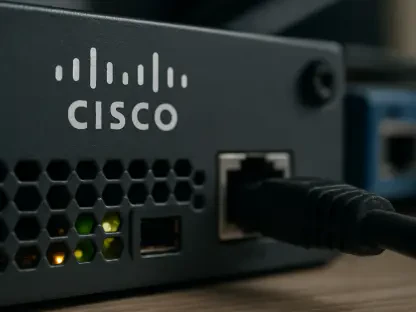Selecting the right Next-Generation Firewall (NGFW) is an essential task for government agencies that are grappling with both budget constraints and escalating cybersecurity threats. These agencies must navigate a complex landscape to implement robust network security measures that ensure the integrity and confidentiality of their data. This guide provides a comprehensive analysis of the considerations and practical steps involved in selecting and deploying a modern firewall solution that meets the unique needs of government entities. With the exponential rise in sophisticated cyber threats, the importance of NGFWs in government cybersecurity cannot be overstated.
NGFWs represent a significant advancement over traditional firewalls, which are often inadequate in addressing the multitude of threats faced by modern networks. Traditional firewalls typically focus on packet filtering, allowing or denying traffic based on predefined security rules. In contrast, NGFWs encompass a broader set of features to provide holistic protection against today’s intricate cyber threats. As government agencies operate within increasingly complex network environments, including on-premises infrastructure, cloud connections, and a variety of connected endpoints, NGFWs emerge as critical tools for monitoring and managing diverse network traffic, securing data across multiple vectors, and mitigating sophisticated cyber threats.
The Necessity of NGFWs in Modern Networks
Modern agencies operate within a multifaceted network environment that includes on-premises infrastructure, cloud connections, and various endpoints, creating complex security challenges. Traditional firewalls, designed primarily for packet filtering and basic stateful inspection, fall short of addressing these challenges effectively. As cyber threats become more advanced, agencies require enhanced security measures to protect their sensitive data and critical infrastructure. NGFWs offer advanced security features that are indispensable for monitoring and managing diverse network traffic, securing data across multiple vectors, and mitigating advanced cyber threats.
NGFWs provide enhanced security capabilities that surpass traditional firewall functionality, making them essential for agencies aiming to fortify their cybersecurity defenses. These firewalls are equipped to handle sophisticated attack vectors, such as SQL injection and real-time application attacks, by addressing vulnerabilities within the infrastructure. NGFWs incorporate a variety of capabilities including application awareness and control, integrated intrusion prevention, and deep packet inspection. Such extensive features bolster an agency’s ability to detect and neutralize threats before they escalate, ensuring the security and resilience of their network operations.
Enhanced Technical Capabilities
NGFWs come equipped with Advanced Threat Protection (ATP), application and user awareness, and SSL/TLS traffic inspection to provide comprehensive security coverage. ATP defends against sophisticated attack vectors by addressing vulnerabilities in the infrastructure, thereby preemptively mitigating risks associated with complex cyber threats. Application and user awareness, facilitated through capabilities like user identification and application control, allow agencies to create policies based on user behavior, implement least privilege principles, and streamline incident response. These features enable security teams to tailor their defenses to specific threats and user activities, enhancing overall security posture.
SSL/TLS traffic inspection is crucial for decrypting, analyzing, and re-encrypting encrypted internet traffic, ensuring visibility and protection against hidden threats. By monitoring encrypted traffic, NGFWs can detect and block malicious activities that might otherwise evade traditional firewalls. The integration of multiple security features into a single platform not only enhances threat detection and response but also helps in managing the complex cybersecurity landscape more effectively. These integrated capabilities provide mechanisms for in-depth network insights, allowing agencies to identify potential security breaches before they fully materialize and cause damage.
Key Features of NGFWs
NGFWs protect against various common and severe cybersecurity threats, including ransomware, phishing, and vulnerabilities associated with cloud environments. Features such as ATP effectively mitigate these risks by blocking malicious activities and securing vulnerable entry points in both data centers and cloud environments. The ability to address such a wide range of threats makes NGFWs an essential component of modern cybersecurity strategies for government agencies.
The integration of multiple security features into a single platform simplifies management by consolidating various security functionalities. This consolidation optimizes IT resources and relieves the burden on overstretched IT teams, making NGFWs an attractive option for government agencies. Furthermore, NGFWs provide enhanced visibility and control over network traffic, allowing agencies to monitor user activities, enforce security policies, and respond to incidents more efficiently. By centralizing security functions, NGFWs enable government entities to streamline their cybersecurity operations and improve overall security posture.
Deployment Considerations
NGFWs can be deployed as hardware-based physical appliances, software-based virtual appliances, or in hybrid models combining both physical and virtual components. Choosing the right deployment method depends on the specific needs and infrastructure of the agency. Hardware-based appliances are suitable for organizations requiring high-performance systems capable of handling substantial traffic volumes. In contrast, virtual appliances offer flexibility and scalability, making them an excellent option for agencies that have adopted cloud-based solutions or require rapid deployment.
Integration with existing systems and the ease of management are crucial considerations in the deployment process. A unified NGFW platform simplifies management by consolidating various security functionalities, optimizing IT resources, and relieving the burden on overstretched IT teams. This approach ensures that agencies can maintain robust security measures while managing their cybersecurity infrastructure effectively. The scalability of NGFW solutions allows agencies to expand their security capabilities as network demands grow without the need for complete system overhauls, providing a future-proof solution to evolving security challenges.
Cost and Future-Proofing Strategies
Given federal budgeting constraints, agencies must invest in scalable, future-proof NGFW solutions to ensure long-term operational integrity. Scalability allows agencies to expand their security capabilities as network demands grow without the need for complete system overhauls. A platform-based approach that integrates FedRAMP-certified cloud capabilities ensures that agencies can adapt their defenses to new and emerging threats without extensive re-budgeting or introducing entirely new systems. This approach smoothens the budgeting process and ensures seamless integration of new security features.
Investing in scalable and future-proof NGFW solutions is a strategic decision that ensures long-term sustainability and security. By choosing a platform that can accommodate new technologies and security features, agencies can maintain robust defenses without frequent, costly upgrades. This approach not only optimizes budget allocation but also enhances the overall security posture by enabling continuous improvements and innovations. Future-proofing allows government entities to stay ahead of evolving threats, providing a resilient and adaptable cybersecurity infrastructure that meets the demands of the modern digital landscape.
Overall Benefits of NGFW Platforms
Selecting the right Next-Generation Firewall (NGFW) is crucial for government agencies facing budget constraints and increasing cybersecurity threats. These agencies must navigate a complex environment to deploy strong network security measures, ensuring data integrity and confidentiality. This guide offers an in-depth analysis of the considerations and steps involved in choosing and deploying a modern firewall tailored to government needs. The surge in sophisticated cyber threats makes NGFWs indispensable in securing government operations.
NGFWs are a significant improvement over traditional firewalls, which are often insufficient for today’s network threats. While traditional firewalls primarily focus on packet filtering and enforcing security rules, NGFWs offer an expanded range of features for comprehensive protection. Government networks are increasingly complex, incorporating on-premises systems, cloud connections, and various endpoints. NGFWs are essential tools for monitoring and managing diverse network traffic, securing data across multiple vectors, and mitigating advanced cyber threats. By integrating NGFWs, government agencies can ensure robust cybersecurity in the face of modern challenges.









